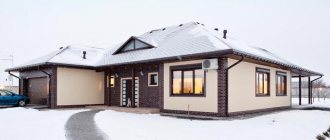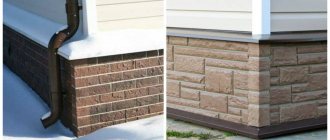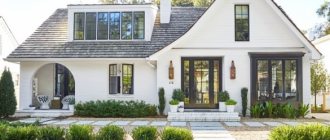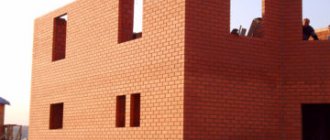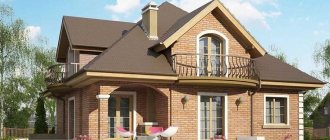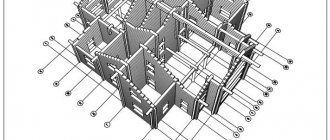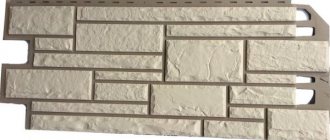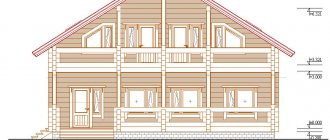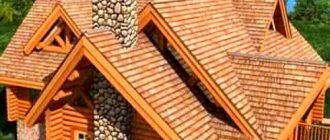6162
From this article you will learn:
- What criteria should be considered when choosing a wooden or brick house?
- What aspects of construction do you need to know about when building a wooden or brick house?
- How justified is the use of wood in the construction of a house for permanent residence?
- What can you say about brick as a building material?
- What misconceptions about wood and brick prevent you from choosing a building material for building a house?
- Is it possible to combine wood and brick when building a house for permanent residence?
When a person decides to build a house, he has to decide what material he will use to build it. Wooden or brick house? When you search for the answer to this question on the Internet, you will find supporters of each of the options. To choose a material, you need to understand the advantages and disadvantages of a house made of wood and brick.
What to consider when choosing a wooden or brick house
Currently, a large number of materials and technologies are used for the construction of cottages and private houses. What exactly your house will be like depends on many factors: financial capabilities, climate, geodetic features of the site on which the building will be located, and, ultimately, the preferences of the owners. The most popular option is to build a wooden or brick house. What material should we choose? Let's look at a number of criteria that will help you decide.
- Environmental friendliness
Wood has pores through which it “breathes,” which promotes excellent air exchange. Brick is made from clay and sand - these are also environmentally friendly materials. However, the same air exchange as in wood does not occur in brick. In addition, the finishing of a brick house is often made of polystyrene and plastic, while a wooden house is finished exclusively with natural materials.
- Thermal conductivity
A brick house has higher thermal conductivity. Wooden walls keep cooler in summer and warmer in winter better. If, at the same temperature, we compare a brick wall 0.5 m thick with a wooden wall 0.2 m thick, then per 1 m2 the heat loss of brick is 1.5 times higher than that of wood.
Such data lead to the conclusion that it is better to build a country cottage from wood, since it heats up faster and cools down more slowly. You need to live in a brick house all the time, because if you don’t warm it up in winter or do it only periodically (for example, on weekends), then microcracks appear in the walls. They fill with moisture, as a result you will feel damp in the room.
- Strength and Durability
How long your new home will last depends not only on the material, but also on compliance with construction technologies. The lifespan of a wooden house will be more than a hundred years if properly felled, dried and treated wood is used during construction. For example, you can use “winter” wood if you dry it naturally or in an oven, and then treat it with impregnations and assemble the tree into a log house.
Recommended reading:
- Service life of a wooden house
- Pros and cons of a house made of rounded logs
- Types of foundations for a private house
Keep in mind that hand-cutting wood is better than sawmilling because the wood will absorb less moisture due to the compaction of the pores. There is also a rule about how to lay logs in a log house: the outer part should be the one that faces the north of the tree.
Brick houses are very reliable if all requirements are met during construction. In particular, only high-quality cement should be used in the solution; it is important to choose the right foundation, etc.
- Architectural forms
When choosing which house to build, wooden or brick, you should take into account that for brick buildings there are significantly more design and architecture options. As for architectural solutions, there are no restrictions for brick: it can be either classical Gothic or a semicircular house in the avant-garde style. Wooden houses look simpler, as they have simple architectural forms.
Any material is suitable for finishing brick walls: plaster, tiles, facing stone. It is enough to cover the wood with special paint or varnish. You can also use siding or clapboard to update the appearance of a wooden house.
- Fire properties and fungus
People often refuse to build a wooden house due to the wood's tendency to catch fire. However, it is worth considering the following points:
- Wood can be treated with special impregnations that will protect the house from fire and ignition. Such impregnations have high fire safety ratings and are comparable to those for bricks.
- If a fire does occur, then wooden floors will last longer than metal ones. This is explained by the fact that metal loses its properties at high temperatures, and wood is protected by a layer of coal, which is formed during a fire.
- Regardless of whether the house is wooden or brick, the curtains, furniture, and flooring are the first to catch fire, and only after that the walls begin to burn. If in a wooden house the electrical wiring is hidden in boxes, then a house made of brick and wood has the same fire-fighting properties.
Fungus appears in the house due to dampness. Even if the wood is treated, but it is damp or waterproofing was not done during construction, fungus will appear. However, it can also grow in a brick house in damp conditions and poor ventilation.
- Price
Of course, brick houses are more expensive than wooden ones. The cost consists of the following components:
- Foundation. A brick house is heavier, so a more reliable and expensive foundation is needed.
- Walls. The construction of wooden walls requires less materials, since wooden walls are thinner than brick ones.
- Decoration inside and outside the house. A wooden house requires minimal finishing, which cannot be said about a brick house.
- A wooden house is cheaper to maintain in terms of heating.
Advantages and disadvantages of a country house made of wood
For creative connoisseurs of handmade goods, confident that not only themselves but also their neighbors will appreciate it, a cottage built of wood is ideal.
The obvious advantage of this material is its affordable price and useful properties, which will be appreciated by lovers of environmentally friendly living away from the “polluted millionaire”.
Buyers also note the low thermal conductivity of wooden walls: you quickly warm up inside them in cold weather and do not “puff up” from the heat in the summer sun.
In addition, due to the lightness of wood, it becomes possible to significantly save on foundation construction. And “breathing” wood, if the initial conditions of its processing are good, will not allow the house to become damp.
Features of the construction of a wooden and brick house
For many years there has been debate about whether a wooden or brick house is better. Each material has pros and cons, so when choosing, people rely on personal preferences.
Let's consider the features of house construction that may influence your decision regarding the choice of material for building your house.
- Foundation
- Roof
- Windows, doors, finishing and equipment
- Walls
- Construction time
Construction begins with laying the foundation - the foundation of the future home. If you make mistakes in the construction of the foundation, this will lead to problems with the entire building, so special attention is paid to this stage. It is easier to build a foundation for a wooden house, because wood is lighter than brick, which means you can limit yourself to a lightweight option. Even screw piles are suitable as the foundation of a wooden house, and such a house will be durable.
Previously, in Russian villages, people built wooden houses on stones held together with clay. Several generations of a family could live in such a house. Of course, such a foundation is not suitable for a brick building. If you compare the costs of the foundation of a wooden and brick house of the same size, then the foundation of a brick house will cost more.
As for the roof, unlike the foundation, there is not much difference between a wooden and a brick house. The roof and attic are mainly made of wood, unless we are talking about reinforced concrete floors. To erect the roof of a wooden or brick house, rafters and sheathing arrive at the construction site from the sawmill. Make sure that the wood is dry, otherwise the roof will not last long. Wooden beams will dry out, curl and change linear dimensions.
Currently, there are a large number of materials for roofing on the market, and the price range is huge. Keep in mind that the higher quality and more reliable the material, the more expensive it is. Thus, the cost of a roof for a wooden and brick house will be the same, if we consider the same roofing material.
When the stage of interior finishing of the house, installation of doors and windows comes, when choosing materials it is necessary to find a balance between price and quality. Rarely do people think about what kind of material is suitable for a brick or wooden house, focusing only on personal preferences. It is not very logical to install an iron door in a wooden house, but such cases occur quite often.
The cost of interior decoration of a room consists of such little things. Therefore, whether for a wooden or a brick house, the price of finishing is not too different. The cost of the work may vary. If in a wooden house the installation of equipment, plumbing, and electricians does not require additional effort and tools, then the cost of finishing a wooden house will be lower.
The stage of wall construction is the moment when the difference in the price of wood and brick is most noticeable. It is believed that wooden walls are significantly cheaper. This is true if there is good forest in your region. If not, there will be additional costs for transporting the tree. Before you start building a wooden house, make sure you have quality timber. After this, you should decide on the type of wooden structures, of which there are many, from frame to rounded logs. If all wooden houses were built, as before, from logs, then the cost of the walls would be very easy to calculate.
The cost of wood depends on how it is processed before building walls. In fact, this also applies to non-wooden houses. Whatever material you choose (arbolit, different types of foam blocks, brick), it has its price. If you compare an ideal house made of wood and brick, then a wooden structure will be cheaper. When building a brick house, you will have to spend a lot of money on interior decoration and insulation, which can be avoided when building a house made of wood.
The high price of building a brick house can be justified by the fact that you can move into it immediately after construction, which cannot be said about a wooden one. It needs to sit for a while to settle. Only after this can you begin interior decoration of the house. It turns out that you already have an almost finished house, but you are forced to live in another place for some period and spend money on rent. With a brick house, this will not affect you: after the construction of the box, the builders will begin interior decoration, after which you can safely move into your new house and celebrate your housewarming.
Main Differences
Discussions about which house is considered the best have been going on for thousands of years. Both materials deserve the right to be leaders, although they are very different from each other.
There are generally three differences between log and brick buildings.
- Price. The cost of natural raw materials and the payment for its installation is lower compared to brickwork. The large thickness of the walls of a brick building and the complex base for it also significantly increases the final price.
- Reliability. Brick cottages are leaders in terms of durability. But with the use of modern processing methods, structures made of profiled timber can also last quite a long time.
- Thermal insulation. To build a family nest made of brick, additional insulation is required, and wood itself has excellent thermal insulation properties.
You will be interested in: Projects of modular houses for year-round use: features of planning and construction
Wood in modern construction
There are several types of wooden walls: rounded logs, planed timber and profiled laminated timber. These materials differ in wood processing technology, which entails a difference in the properties of houses. Let's consider the advantages and disadvantages of each material.
Rounded log
If you decide to build a house from logs, then pine, fir and spruce are usually used. Before construction begins, the material undergoes multi-stage processing, in particular, the wood is dried at high temperature. It is easy to breathe in such a house, and it looks solid. However, be prepared for numerous material features.
The main problem is shrinkage. She will not allow you to quickly move into the house, because this process lasts about a year. For each floor, the tree shrinks about 10 centimeters. And even after shrinking, you cannot move into the house; there are still several stages of work to be done. When shrinking, cracks appear that need to be repaired, otherwise the heat in the house will not linger for long.
The first year you cannot install windows or do any finishing. Wood outperforms brick in terms of heat transfer resistance, but this does not allow calling a wooden house 100% energy efficient due to the appearance of cracks during shrinkage and insufficient wall thickness. It is measured at the seams - the thinnest place. The maximum thickness of log walls is 20 centimeters, which is not enough for most regions. As a result, to keep the house warm, you will have to spend a lot of money on heating the room or live in the house only in the summer. Of course, wooden walls can be insulated, but then the beautiful natural material will be hidden under the cladding. In addition, the tree needs to be constantly looked after.
It turns out that houses made of rounded logs have a lot of disadvantages. However, they are built quite often, because they have a special homey feel. If you know and follow the rules of caring for such a house, it will serve you for a long time.
Glued laminated timber
Glued laminated timber is an excellent option for building a wooden house, because it simultaneously retains the advantages of natural wood and is devoid of its main disadvantages. Typically, timber is made from coniferous wood: spruce, pine, larch. Individual solid wood lamellas are longitudinally spliced to produce the finished product. The fibers of adjacent beams must be placed in different directions. The result is a durable material with pre-predicted properties. A house made of laminated veneer lumber is quite easy to build thanks to the profiled ends of the timber. The structure turns out to be very strong and reliable.
Advantages of the material: high strength, no shrinkage and cracks. Walls made of laminated veneer lumber do not need to be finished either outside or inside. The maximum wall thickness is 30 centimeters, so this material is not suitable for all regions. In terms of cost, a house made of laminated veneer lumber will be more expensive than rounded logs.
A wooden house today does not necessarily have walls made of durable laminated veneer lumber or massive logs. Quite often, inexpensive and lightweight frame-panel and frame-panel houses are built.
A house built using frame technology can hardly be called wooden, because in fact it only has a frame made of wood. The walls are filled with any material, but not wood, and have a multi-component structure.
Frame walls are sheathed on the outside with wood-polymer sheets or cement-bonded particle boards. The first material is made from wood processing waste. The inner side of the frame walls is sheathed with environmentally friendly materials: plasterboard, plywood, boards. In addition, insulation and wind protection are placed in the internal cavity of the walls.
A frame house is an excellent option for inexpensive and quick construction of a house. This house is very warm. In addition, modern technologies make it possible to transform the appearance of such a structure. For example, the outside of a house can be covered with facade panels simulating timber, stone, logs, brick, and so on. As a result, your home will look no worse than a brick plastered house.
It happens that after covering a frame house it is impossible to understand what the house was built from. There is a cheaper, but no less beautiful option - this is the half-timbered design shown in the photo above.
If you are counting on the most budget-friendly option for a wooden house, then your choice is a frame house. You can sheathe the outside and not worry about the appearance of the building. If price is a decisive factor when building a house, then there is no need to think about whether a wooden or brick house, choose a prefabricated structure.
You may hear that frame houses are called Finnish, and this is no coincidence. Frame houses are assembled as a constructor; this technology for the construction of low-rise buildings came to us from the Scandinavian countries. To build a wooden house in Russian means to build it from a log frame.
Building a house from calibrated lumber will be quite expensive and, in addition, requires professional carpenters, which are not available in every city. But such a building also has advantages: strong walls and durability of the building.
In recent decades, people have become interested in the original Russian craft - wooden architecture. For the construction of such a house, only high-quality calibrated material is suitable. If you want to build just such a house, contact the designers, they will develop a stunning project for you.
However, several problems will have to be solved. One cubic meter of wood costs from 3,000 rubles, which is not much cheaper than brick. Brick can be brought on a dump truck, which cannot be done with wood, since it is a long material. Difficulties may arise with unloading and storing wood. Another problem is that cutting down coniferous forests (on an industrial scale) is only possible in the north of Russia, so it is necessary to organize the delivery of the material. The further south you are, the higher the transport costs.
We have already found out that building a frame house is the most budget option. However, it must be taken into account that such houses are built very rarely in the south. In the south, people don’t think twice about whether to build a brick or a wooden house, because in the summer they want the house to be cool. And in the south the heat lasts for several months, and the winter is short and not cold. This explains the fact that the vast majority of houses in the south are built of brick.
In addition, when it is hot, fires often occur, so residents of the southern regions definitely choose a brick house. Of course, fires occur not only because of the weather; a fire can break out in any house, but the consequences of a fire in a brick and wooden house are completely different. The brick will only become smoked; in most cases, the wood will burn to the ground, even if the material is treated with a fire-retardant compound.
Energy saving, heat dissipation
Any building material has its own thermal characteristics. Wood, for example, is an excellent “heat protector” and retains heat very well in cold weather, while brick cannot boast of such properties. A brick house must be constantly heated so that it does not freeze.
Otherwise, you will then have to wait a very long time until the walls warm up and you can live in the house. There are no such problems with a wooden house, since the wood does not freeze. You can come at any time, warm up the air inside and that’s it, you can live right away.
Building your own home is a huge undertaking. Moreover, the troubles begin at the design stage, since often a lot of disputes arise in the family about which house to choose, what design and what material to build it from.
Most often, battles rumble when choosing whether a wooden or brick house will become a family nest. Supporters of both options find a lot of arguments in favor of their choice, look for expert opinions on the Internet, calculate the cost of building a brick house and a wooden frame, estimate construction time, durability, operational advantages and disadvantages. Let's look at the main pros and cons of such buildings and decide which is better, a wooden house or a brick one.
Brick and wood are the main materials from which houses are built; each of these materials has its own advantages and disadvantages.
The main advantage of brick houses over wooden ones is their strength.
Yes, a brick house will last much longer and will be more resistant to the aggressive manifestations of nature, without losing its appearance and performance characteristics for years.
Table comparing wood and brick by thickness and thermal conductivity.
The second advantage is the greater fire safety of a stone or brick structure compared to any wooden structures.
This is already clear to everyone. Brick does not burn on its own and this already reduces the risk of fire. Of course, many fires do not start because the walls catch fire; the source is always inside the house and it is the decoration, furniture, etc. that burns first.
But even in this case, a stone cottage has the advantage that it suffers less from a fire, its walls will not burn, and it will be possible to restore the house over time. A fire does not benefit any house, but a brick one will only slightly reduce its strength characteristics after it, and a wooden one may die completely.
But if you install electrical networks and heating in compliance with all safety measures and follow operating rules, then the risk of fire can be reduced to extremely insignificant values, and then it does not matter whether your house is wooden or brick. These factors are much more important in terms of safety than the material of the walls of your cottage.
Table comparing the properties of brick with other materials according to various parameters.
The third advantage of brick and stone is that it provides greater design options. Wood is a wonderful and beautiful material from which our ancestors created real masterpieces of architectural architecture, but modern building materials can provide a much wider range of possibilities for imagination. You can build a house of any shape and architectural style from stone - rounded corners, fancy arches, a beautiful colonnade, etc.
etc. - all this is difficult to do from timber, but easy from brick. And if we add to this the possibility of using various finishing materials: from marble tiles to stucco, it becomes clear that in this regard, a comparison will show the absolute advantage of a brick rather than a wooden tower.
Return to contents
Characteristics of various types of bricks.
The main disadvantage of a brick house is its price. Such buildings are always much more expensive than their wooden competitors. This is due to many factors: there is not only the cost of materials, but also such a simple fact as the fact that brick has much greater thermal conductivity than wood, which means that in order to keep the cottage warm, it is necessary to make thick walls, and even additionally insulate them.
Wood is much better in this regard. If you make a log house correctly, then heating it will consume very few resources, and the heat will last longer and easier. So if for someone the issue of price and heating costs is fundamental, when choosing a brick or wooden house, you will have to give preference to the latter.
Another disadvantage, close to the one mentioned above, is that stone houses cannot be used for temporary residence.
If you leave the house even for a short time, it will become cold and damp, and the spirit of the non-residential premises will haunt you for a very long time. In order to get rid of it, you will have to spend a lot of time and fuel on heating. If you want to use the house under construction not for permanent, but seasonal residence, refuse bricks.
Return to contents
Comparative diagram of the thermal conductivity of wood and brick.
The disadvantage of brick construction turns into a plus for wooden construction; this directly affects the price of materials and installation. The cost of a structure made of timber or logs will be significantly lower than that of competing materials. In addition, in some regions, purchasing good quality timber is not only relatively cheap, but also simple, which means that the cost of delivery can also significantly affect the final cost of the cottage.
The second important advantage is the environmental safety of wood. The tree is alive and has many useful properties.
The odors released can have a beneficial effect on human health and mood. The pleasant wood color of the walls is attractive to the eye and makes it easy to relax and tune in to a positive wave. In addition, wood, as a living material, is able to “breathe”, allowing partial air to pass through, which is why dampness and mustiness are rare guests in a wooden house.
As already mentioned, wood has better thermal conductivity, which means not only warmth in winter, but also coolness in summer, which will be natural and not artificially caused by climate control devices. Greater thermal conductivity means smaller wall thickness, and smaller wall thickness means not only material savings, but also a low weight of the structure. And the low weight of the house means significant savings on the depth and width of the foundation, the price of which can reach a third of the entire cost of the house.
Table of physical properties of wood of different species.
Conditional disadvantages, as already mentioned, include less architectural freedom of wood. But if you remember what the cities of our ancestors looked like, you can slightly doubt this, and having learned that you can easily install modern polymer siding on a beam or rounded log and give the house any look, then doubts will grow to the level of confidence in the fallacy of such an opinion .
The durability of wood can be significantly increased with the help of modern technologies.
You will have to carefully think through your situation and choose the option that is right for you.
- Date: 02/16/2015 Comments: Rating: 48
What is better for building a house - wood or brick? That's the question, that's where the problem is.
It would seem, what’s so complicated about this? However, this is not quite true. The question is quite serious and does not have a clear answer.
A wooden house lasts 50 years, a brick house - 100 or more.
To answer it correctly, you must first decide on the purpose of the future housing, namely: is it temporary or permanent.
Option 1 is characterized by a light or medium type room: a relatively small area, the ability of the structure to withstand low ambient temperatures. Cottages and country houses fit well into this category.
Option 2 (permanent residence) provides for a more “heavy” room, the heating equipment of which is connected to the gas main. Such houses can easily withstand severe frosts (down to – 40 ° C and below).
The whole truth about brick
Wood as a building material is generally used in certain regions. While brick (clay, silicate, hyper-pressed) is used everywhere, because there are brick factories in all regions.
When building, first of all, you need to answer the question “Brick or wooden house - which is better to prefer?” First of all, these materials are compared by thermal conductivity. The closer the thermal conductivity coefficient is to zero, the warmer the house will be.
Determining whether a wooden or brick house is warmer is quite simple by looking at the table of thermal conductivity coefficients. For solid red and sand-lime brick it is 0.8 W/m*K, for clinker it is 0.9. These are quite high coefficients, which indicate that a house made of such materials does not retain heat well. The wood indicator is six times lower and amounts to 0.14 W/m*K. Thus, wood wins in terms of thermal conductivity.
Only ceramic blocks, which are also called warm ceramics, can be compared with wood. The thermal conductivity of hollow brick is between these coefficients, but such brick is less durable. To build a house from hollow bricks, well masonry technology is used, which looks like this:
Two parallel walls are laid out of hollow bricks, the walls are firmly fastened together with jumpers made of bonded rows. This type of masonry resembles wells, which is why the technology is called well technology. During the construction of walls, wells can be filled with cellular concrete, loose or foam insulation. The masonry is quite reliable thanks to the steel mesh, which is embedded in every fourth horizontal row. This is shown in the previous photo.
Well brickwork has low thermal conductivity, almost like wood, high strength and fire safety. In addition, such a house will last for many decades. All these advantages make you cast aside doubts whether to choose a brick or wooden house. Well brickwork is superior to both wood and solid brick in many respects.
This is not the only option to build an inexpensive brick house with low thermal conductivity. In order not to build walls two or three bricks thick, which requires a powerful foundation, the facade of the house can be insulated with effective thermal insulation materials. Very popular warm plaster systems and ventilated facades, which can be frameless made of decorative bricks and wall-mounted, in which the facing material is hung on the sheathing, cannot do without them.
Advantages of a wooden house
The disadvantages of brick turn into the advantages of wood:
- lower price; environmental safety; thin walls that can “breathe”; the house is warm in winter and cool in summer; the foundation is narrow.
In some regions of Russia, wood is much cheaper than brick, and it is very easy to find. Delivery costs are also very low.
This affects the final cost of the cottage or house (Fig. 2). Wood, rounded logs, timber are environmentally safe.
These materials emit odors that are beneficial to the health of others. Wood is pleasant to look at, it “breathes” and allows clean air into the room. Dampness in a wooden house is very rare.
In summer it is cool in a wooden house; there is no need to install air conditioning. The walls of the house are much thinner than brick, which reduces the weight of the house. Low weight allows you to save on the depth of the foundation, which can be made much narrower.
Disadvantages of a wooden structure:
- low degree of freedom in creating an architectural appearance; low durability; wood is afraid of fire and rots; the building requires constant maintenance and repair; laminated veneer lumber is more expensive than brick; electrical installations in the house must be done with high quality and taking into account fire safety.
The degree of architectural freedom can be increased by using a variety of polymer sidings. Low durability can be extended using modern technologies.
Wooden or brick house: all the pros and cons
The advantages of a wooden house are as follows:
- Strength.
- Resistant to all weather conditions.
- Insects and harmful microorganisms will not be able to destroy the building.
- The facade will not have to be repaired for several decades.
- The brick is fire resistant. In case of a minor fire, the house can be easily restored.
As you can see, brick houses have many advantages, but they are not without significant disadvantages , including:
- Brick is a heavy material, so the foundation for a brick house must be strong and expensive.
- The price of brick is higher than that of wood materials; accordingly, the cost of erecting brick walls is quite high.
- Without decorative finishing, a brick wall does not look very attractive.
If we analyze the indicated advantages and disadvantages of a brick house, we can draw the following conclusion: it is better to build a country house from wood for living in the warm season. The brick is suitable for building a cottage for year-round use.
However, before making a decision, it is worth considering the pros and cons of natural wood.
Advantages of wood building materials:
- Wood is lighter than brick, so a foundation for a house made of wood will cost you little. It can be piled or columnar.
- The construction of wooden walls takes very little time. For example, a house made of laminated timber takes 2 months to build.
- Wood is cheaper than brick, so the cost of building a wooden house will be lower than that of a brick one.
- If you compare a wooden and brick house in terms of environmental friendliness, then wood is certainly the leader. This is the cleanest building material on the modern market.
- It is easy to maintain a comfortable temperature in a wooden house. In winter, a well-heated house retains heat for a long time, and in summer, on the contrary, the room is cool.
The main disadvantages of buildings made of logs and timber:
- A large number of factors can lead to the fact that a wooden house begins to collapse: moldy fungi, insects. Eventually, the tree may begin to rot.
- If a fire occurs, it is extremely difficult to save a house because the fire quickly spreads along the wooden walls.
- If solid materials of natural moisture were used during construction, they will gradually dry out, which will lead to shrinkage of the house. In this case, it is not possible to move into the house immediately after construction; you have to wait a year and a half to finish the finishing and equip the house. Only after this is he ready for the housewarming party.
Detailed comparison of the main characteristics
For a deeper understanding of the difference between the two popular materials, let's consider their numerical characteristics.
Distinctive properties of wood and brick:
| Characteristics | Brick | Tree | ||
| Silicate | Clay | Log | Glued laminated timber | |
| Density, kg/m3 | 1780 | 1630 | 540 | 450 |
| Thermal conductivity, W/m°С | 0,81 | 0,64 | 0,16 | 0,14 |
| Weight of 1 m2 of wall, kg | 1200 | 1150 | 225 | 100-150 |
| Eco-Friendly Factor | 5-6 | 1 | ||
| Sound insulation, dB | 42-60 | 41-50 | ||
| Labor intensity of construction work, person*h/m3 | 2 | 1 | ||
conclusions
An analysis of all the pros and cons shows that wood has many advantages over brick. This will become even more obvious if you look at the most modern type of wooden building materials - laminated veneer lumber. It does not have many of the disadvantages of solid wood: it is subject to minimal shrinkage, and is more resistant to fire, biological and climatic damage. Glued laminated timber also has lower thermal conductivity. And its strength is 2.5 times higher than that of solid wood with natural moisture.
The difference in cost between brick and laminated veneer lumber is small. But when choosing the first material to build a cottage, you will also have to incur additional costs. Thus, more funds will be required for the construction of the foundation, construction of walls, insulation and interior decoration. Thus, laminated veneer lumber is superior to brick in almost all respects.
An alternative option instead of building a wooden or brick house
If you wish, you can combine wood and brick, building a combined house for yourself. The first floor is built from stone, and the second from logs or timber. This is an excellent alternative to a house made of one material.
This combined solution has many advantages, including:
- A solid first floor made of brick will not allow the second floor made of wood to rot. This significantly improves the performance characteristics of the house.
- In the case of a combined house, on the ground floor it is recommended to place rooms associated with the possibility of ignition: kitchen, sauna, fireplace room, heating rooms. This will provide additional fire safety.
- If we consider the cost of building a combined house, it is lower than that of a completely brick house. In addition, a house made of brick and wood is much more environmentally friendly. It is better to place a children's room and bedrooms on the second wooden floor.
Features and advantages of stone houses
Long service life and wear resistance of the material
Since ancient times, brick houses have been favorably distinguished by their stable quality, since they were erected only by professional builders, and they were owned mainly by wealthy people.
The same applies to the main building material - brick. Over time, its properties have been improved so much through new technologies and experiments that this material has become an almost indispensable element for the walls of any home.
